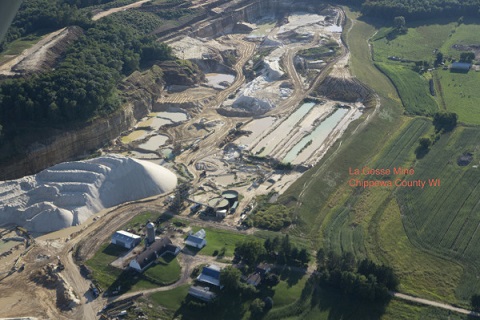
Frack Brine is Ineffective for Dust Control and a Health Hazard
November 7, 2018
Landowners Beat National Fuel in Court to Preserve Piece of Paradise
December 10, 2018WIS. TRIAL COURT RULES IN FAVOR OF ANTICIPATORY NUISANCE CLAIMS AGAINST FRAC SAND MINE; OMNITRAX CALLS IT QUITS
In a written decision issued on Election Day, the Jackson Co. Wis. Circuit Court, Judge Scott Horne of La Crosse presiding, ruled that the anticipatory nuisance claims of a group of private landowners against the proposed OmniTRAX frac sand facility would be allowed to proceed to trial. In response, OmniTRAX’s lawyer immediately informed the judge that a trial would not be necessary, because in light of the court’s decision, OmniTRAX intends to abandon the project, before the first shovel has broken ground.

The Jackson Co. court’s decision in favor of the landowner plaintiffs in Ripp, et al. v. OmniTRAX follows the August 9th decision of the Wisconsin court of appeals in the case of Krueger, et al. v. AllEnergy, which concluded that Wisconsin law does recognize a claim for “anticipatory nuisance” in situations in which the harm has not yet arisen but is inevitable and certain if a planned course of conduct by a defendant is followed.
The plaintiffs in the case against OmniTRAX are three married couples who own land and live next to the area where the frac sand mine, processing facility and rail load-out facility were proposed to be constructed. They have been seeking to prevent the substantial disruption of their rural quality of life and health from the creation of a neighboring frac sand facility. They alleged in their complaint that the proposed OmniTRAX facility would create nuisance conditions, including, but not limited to toxic air pollution, water pollution, noise pollution, light pollution, ground disruption and vibration due to blasting, destruction of agricultural and forested lands and landscapes and wetlands, adverse impact on endangered species, depletion of groundwater, and loss of property values. They further alleged that siting this mine as contemplated would unreasonably interfere with the rights of these landowners to the quiet and peaceful use and enjoyment of their property rights.
Specifically, Judge Horne’s decision cited the following allegations from the plaintiffs’ amended complaint as forming the factual basis for the anticipated nuisances:
- The dimensions of the project are substantial–a 1018 acre development to mine, process and ship local sand resources to Texas and Montana. This includes a 735 acre sand mine, 40 acre processing facility and 200 acre Transload Facility, and the balance consisting of access roadway and conveyor land.
- The 735 acre mine includes the mechanical removal and on-site stockpiling of up to 70 feet of overburden (silt, loan, clay, rock or combinations) from the top of the sand formation. The proposed mine site would operate from 6 am – 9 pm Monday, Friday and Saturdays.
- Heavy equipment including large tracked excavators or rubber-tired front-end loaders will be used to excavate the sand. Blasting may be used depending on the geological formation. Extraction of the sand resource will continue to a depth of 130 feet below current ground surface elevation and will continue for approximately 25 years. An estimated 76 million tons of pay material will be excavated and trucked to the Processing Facility.
- The processing facility is described as including large sand stockpiles; waste sand storage; stormwater ponds; material hoppers and conveyors; rock crusher; screening equipment; sand washing and sizing equipment; wash-water treatment clarifier; rotary sand dryer; sand storage silos; offices; equipment parking; and employee parking. The structures at the facility are expected to be up to 150 feet high and will house equipment and machinery that may operate 24 hours a day and 7 days per week.
- The sand will travel on a 1.94 mile long overland conveyor from the Processing Facility to the Transload Site. This facility is approximately 40 acres and will include 5.77 miles of railroad track, storage silos, railcar loading equipment, stormwater ponds and access roads. The Facility may hold up to 500 45-foot railcars and 12 75-foot locomotives. The business anticipates loading 4-5 unit trains (each consisting of 110 cars and 4 locomotives) per week and may operate 24 hours/day and 7 days/week.
- Up to 3 million tons of sand may be shipped off site each year.
- Emission factors published by the EPA suggest over 140 pounds of silica dust will be emitted each day.
- Adverse impacts to local air quality and to plaintiffs as surrounding property owners are inevitable based on the facility proposal, permit applications and data.
- Negative impacts to water quality are inferred based on the plans for a high capacity well which would draw 800 gallons per minute, 24 hours/day for a total of 1,152,000 gallons per day.
- Lighting will be a significant issue for neighbors as the structures will be at heights over 100 feet and lighting will not be contained by berms and trees. Furthermore, the Nonmetallic Mining Ordinance requirements fail to meet safeguards promulgated by the Illuminating Engineering Society of North America definition of cutoff increasing the likelihood of light pollution to the Plaintiffs neighboring properties.
- The Mining Agreement contains no limitation at the Transload Site as to noise levels or hours of operations. In the January of 2012 “Silica Sand Mining in Wisconsin” report, the DNR states that noise from operations can affect the quality of the recreational users and that excessive noise can cause annoyance and adverse health effects. Such annoyance will include sleep disturbance and speech interference.
- Many protections set forth in the Nonmetallic Mining Ordinance were diminished or removed by the conditions In the Mining Agreement with the Town of Alma. Negative noise, dust, air pollution, water and light impacts are inevitable.
“The demise of the frac sand facility before it was even constructed takes an enormous weight off of the shoulders of these individual landowners,” said Tim Jacobson, the current attorney for the plaintiffs. “Each of them had purchased their properties specifically to have a beautiful, peaceful, rural haven to enjoy the quiet scenery of nature. Everything they cherished about their lands was about to be destroyed by a massive, earth-shaking, polluting industry that would have noisily ground on around the clock, and would have thrust them into a living hell.” Jacobson added, “Had the frac sand facility been built, they would have worried about every breath of air they breathed and every sip of water they might take from their wells. Every night of sleep would be disrupted, and the social fabric of this rural community would be torn apart.”
Jerry Schmidt is a resident of the Town of Alma in Jackson County, a former Town Supervisor there, and a current member of the Jackson County Board. He said, “The needs and best interests of the many–clean air, clean water, preservation of land for wildlife and people to live in peace–have at last prevailed over the self-interest of a few. This is the foundation of democracy in this country. My wife and I are relieved beyond words and so grateful to all who contributed time, talent and many other resources to finally make this happen.”
Kay Finch, who resides in close proximity to where part of the OmniTRAX facility was planned to be constructed, said, “My husband Tim and I, along with my parents, owned and operated a large cranberry growing operation in Jackson County spanning decades of our lives. During that period, we came to recognize and cherish the land in which we lived, the clean air we breathed and precious water resources we became so dependent upon. We recognized that all of these resources are finite and, in order to preserve our quality of life for future generations to come, we needed to preserve and protect our resources. Life cannot exist without the basics of clean air, pristine waters and uncontaminated soils in which to grow our foods.”
Peter Segerson, a resident of the Town of Adams who worked for the DNR from 1979 until 2014, said, “Wetlands are water filters, important to wildlife, flood protection, and they recharge groundwater supplies. Filling wetlands and destroying Wisconsin farm lands and productive forests, for the relatively short time of frac sand production, goes against wise-use conservation. There is nothing more important to life than having clean air to breathe, pure water to drink, and fertile soils for farms and forests.”
Retired judge and attorney Tom Lister, who started the lawsuit against OmniTRAX’s now-bankrupt predecessor Terracor almost three years ago in January 2016, expressed appreciation for finally getting resolution. “These good people have waited with the mine’s motion to dismiss hanging over their heads since February 2016, which was incredibly demoralizing to them. This week’s decisions by the court and by the mining company show that the long, hard legal battle was worth it.” Lister added, “It demonstrates to the world that ordinary citizens can protect their private property rights from destruction using the power of the law. We hope the court decisions in the cases against AllEnergy and OmniTRAX will embolden citizens to stand up for their rights against exploitative corporate interests.”
And there is more:
- The Memorandum decision and order denying motion to dismiss
- Chris Hubback has written a story entitled Jackson County Frac Project to be Scrapped After Legal Challenge
- This information provided by the Frac Sand Sentinel



